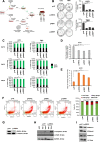Epigenetic-focused CRISPR/Cas9 screen identifies (absent, small, or homeotic)2-like protein (ASH2L) as a regulator of glioblastoma cell survival
- PMID: 37974198
- PMCID: PMC10652464
- DOI: 10.1186/s12964-023-01335-6
Epigenetic-focused CRISPR/Cas9 screen identifies (absent, small, or homeotic)2-like protein (ASH2L) as a regulator of glioblastoma cell survival
Abstract
Background: Glioblastoma is the most common and aggressive primary brain tumor with extremely poor prognosis, highlighting an urgent need for developing novel treatment options. Identifying epigenetic vulnerabilities of cancer cells can provide excellent therapeutic intervention points for various types of cancers.
Method: In this study, we investigated epigenetic regulators of glioblastoma cell survival through CRISPR/Cas9 based genetic ablation screens using a customized sgRNA library EpiDoKOL, which targets critical functional domains of chromatin modifiers.
Results: Screens conducted in multiple cell lines revealed ASH2L, a histone lysine methyltransferase complex subunit, as a major regulator of glioblastoma cell viability. ASH2L depletion led to cell cycle arrest and apoptosis. RNA sequencing and greenCUT&RUN together identified a set of cell cycle regulatory genes, such as TRA2B, BARD1, KIF20B, ARID4A and SMARCC1 that were downregulated upon ASH2L depletion. Mass spectrometry analysis revealed the interaction partners of ASH2L in glioblastoma cell lines as SET1/MLL family members including SETD1A, SETD1B, MLL1 and MLL2. We further showed that glioblastoma cells had a differential dependency on expression of SET1/MLL family members for survival. The growth of ASH2L-depleted glioblastoma cells was markedly slower than controls in orthotopic in vivo models. TCGA analysis showed high ASH2L expression in glioblastoma compared to low grade gliomas and immunohistochemical analysis revealed significant ASH2L expression in glioblastoma tissues, attesting to its clinical relevance. Therefore, high throughput, robust and affordable screens with focused libraries, such as EpiDoKOL, holds great promise to enable rapid discovery of novel epigenetic regulators of cancer cell survival, such as ASH2L.
Conclusion: Together, we suggest that targeting ASH2L could serve as a new therapeutic opportunity for glioblastoma. Video Abstract.
Keywords: ASH2L; CRISPR/Cas9 screen; Chromatin modifiers; Epigenetic; Glioblastoma; sgRNA library.
© 2023. The Author(s).
Conflict of interest statement
APC is co-founder and an employee of Caeruleus Genomics Ltd and is an inventor of several patents related to sequencing technologies filed by Oxford University Innovations.
Figures





References
Publication types
MeSH terms
Substances
Grants and funding
LinkOut - more resources
Full Text Sources
Molecular Biology Databases
Miscellaneous

